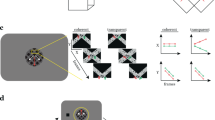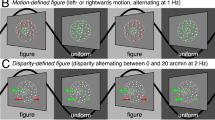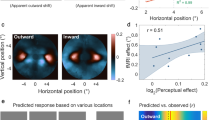Abstract
WE describe here a new view of primary visual cortex (VI) based on measurements of neural responses in V1 to patterns called ‘illusory contours’ (Fig. la, b). Detection of an object's boundary contours is a fundamental visual task. Boundary contours are defined by discontinuities not only in luminance and colour, but also in texture1–3, disparity4 and motion5–7. Two theoretical approaches can account for illusory contour perception. The cognitive approach emphasizes top-down processes8,9. An alternative emphasizes bottom-up processing. This latter view is supported by (1) stimulus constraints for illusory contour perception10–14 and (2) the discovery by von der Heydt and Peterhans15–17 of neurons in extrastriate visual area V2 (but not in V1) of macaque monkeys that respond to illusory contours. Using stimuli different from those used previously15,16, we found illusory contour responses in about half the neurons studied in V1 of macaque monkeys. Therefore, there are neurons as early as V1 with the computational power to detect illusory contours and to help distinguish figure from ground.
This is a preview of subscription content, access via your institution
Access options
Subscribe to this journal
Receive 51 print issues and online access
$199.00 per year
only $3.90 per issue
Buy this article
- Purchase on Springer Link
- Instant access to full article PDF
Prices may be subject to local taxes which are calculated during checkout
Similar content being viewed by others
References
Beck, J. Biol. Cybern. 48, 125–130 (1983).
Julesz, B. IRE Trans. Inf. Theory. IT-8, 84–92 (1962).
Julesz, B. Nature 290, 91–97 (1981).
Julesz, B. Foundations of Cyclopean Perception (Univ. Chicago Press, Chicago, 1971).
Nakayama, K. & Tyler, C. W. Vis. Res. 21, 427–433 (1981).
Nakayama, K., Silverman, G. H., MacLeod, D. I. A. & Mulligan, J. Perception 14, 225–238 (1985).
van Doorn, A. J. & Koenderink, J. J. Expl Brain Res. 45, 179–195 (1982).
Gregory, R. L. Nature 238, 51–52 (1972).
Rock, I. & Anson, R. Perception 8, 665–681 (1979).
Smith, A. & Over, R. Perception 6, 441–447 (1977).
Smith, A. & Over, R. Perc. Psychophys. 25, 95–98 (1979).
Paradiso, M. A., Shimojo, S. & Nakayama, K. Vis. Res. 29, 1205–1213 (1989).
Gregory, R. L. Perception 6, 113–119 (1977).
Takahashi, S., Kaihara, T., Takemoto, A., Ido, K. & Ejima, Y. Vis. Res. 32, 1709–1718 (1992).
von der Heydt, R., Peterhans, E. & Baumgartner, G. Science 224, 1260–1262 (1984).
von der Heydt, R. & Peterhans, E. J. Neurosci. 9, 1731–1748 (1989).
Peterhans, E. & von der Heydt, R. J. Neurosci. 9, 1749–1763 (1989).
Spitzer, H. & Hochstein, S. J. Neurophysiol. 53, 1266–1286 (1985).
Shapley, R. & Gordon, J. Perc. Psychophys. 37, 84–88 (1985).
Shapley, R. & Gordon, J. in The Perception of Illusory Contours (eds Petry, S. & Meyer, G. E.) 109–115 (Springer, New York, 1988).
Grossberg, S. & Mingolla, E. Psychol. Rev. 92, 173–211 (1985).
Lamme, V. A. F., van Dijk, B. W. & Spekreijse, H. Nature 363, 541–543 (1993).
Hochstein, S. & Shapley, R. M. J. Physiol., Lond. 262, 237–264 (1976).
Merrill, E. G. & Ainsworth, A. Med. Biol. Engng 10, 662–672 (1972).
Milkman, N. et al. Behav. Res. Meth. Instrum. 12, 283–292 (1980).
Wong-Riley, M. Brain. Res. 171, 11–28 (1979).
Hawken, M. J., Parker, A. J. & Lund, J. S. J. Neurosci. 8, 3541–3548 (1988).
Author information
Authors and Affiliations
Rights and permissions
About this article
Cite this article
Grosof, D., Shapley, R. & Hawken, M. Macaque VI neurons can signal ‘illusory’ contours. Nature 365, 550–552 (1993). https://doi.org/10.1038/365550a0
Received:
Accepted:
Issue Date:
DOI: https://doi.org/10.1038/365550a0
This article is cited by
-
Second-Order Visual Mechanisms: Review of Research
Neuroscience and Behavioral Physiology (2023)
-
Cognitive penetrability of scene representations based on horizontal image disparities
Scientific Reports (2022)
-
Dogs (Canis lupus familiaris) are susceptible to the Kanizsa’s triangle illusion
Animal Cognition (2022)
-
Feedback generates a second receptive field in neurons of the visual cortex
Nature (2020)
-
Everything is subjective under water surface, too: visual illusions in fish
Animal Cognition (2020)
Comments
By submitting a comment you agree to abide by our Terms and Community Guidelines. If you find something abusive or that does not comply with our terms or guidelines please flag it as inappropriate.



